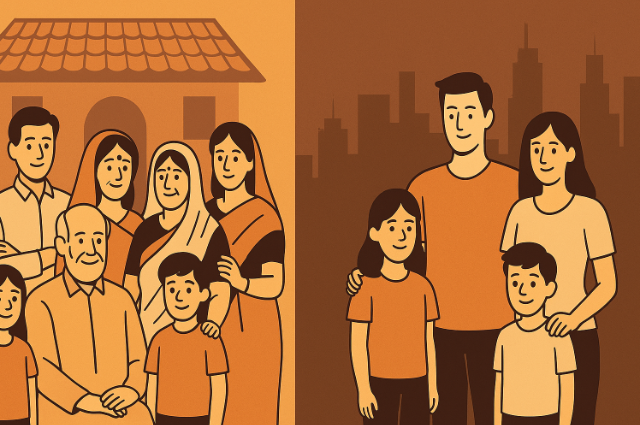
In the 21st century, which has brought so many modern concepts and has replaced so many conservative ways of life or the traditional system that had been working for a long time, it has also been able to affect the family structures, which was once dominating since time immemorial, and now it has completely changed with modern thoughts and individuality.
If we step back in history, we can see many joint families that were a part of the earlier family structures in the country. India used to be an agricultural economy, where people from most of the families were part of the same farmland and used to cultivate and live under the same roof, and had a large family, which was mostly dependent on agriculture. It was culturally well-emphasised that collectivism with respect for elders and sharing responsibilities among themselves were deeply respected in earlier times.
However, with modern times, this process has completely changed and the family structure has evolved from joint families to being more of nuclear families or small. There could be several reasons for that, for example, the rapid urban development has led to space constraints in many cities, which has led to having very small families, i.e., the nuclear family. Apart from that, also from a village to a city there is the migration process, be it for jobs, education, or better lifestyles. Sometimes people migrate, which causes separation from their extended or joint families, and leads to the rise of more of a smaller or a nuclear family.
Moreover, with the rise of more financial independence, be it among men and women, they prefer to have a small family, also receiving less dependence on their elder parents for income or decision making. Thus, it is common now to prefer a small family for more privacy and autonomy, as being in a large family isn't easy to achieve, as elders always try to dominate because of their patriarchal mindset.
With more people getting educated and adapting themselves to the modern lifestyle, it has become common where people to prefer to have a small family for more authority. And there has been a recent focus or emphasis on more individualism over collectivism, for more personal space among the members. Thus, the youth seeking personal freedom, career choices, and leaving a nuclear family has turned a part of the family structure, and is now turning into a common scenario all over the country.
We can also take the example of the rise of Western culture in the Indian conservative families, which can be seen in more nuclear families. It can be seen from the West or in the Korean and Japanese families, which prefer to live in a nuclear family, with only the parents and their children. Thus, living with the elders or the grandparents has become a rare phenomenon in the country as more people are oriented toward having a small family, and it can have various financial, educational, and personal reasons, too.
Also, with the rise of the women's workforce, it has become common that they usually prefer to have a small family or a part of a very nuclear family, which would not hinder their personal and private life. Nuclear families offer more privacy and smooth decision-making for them, which they often find difficult in a large family where the elders try to stop their way for jobs and other outside activities except at home. And joint families also can lead to clashes in opinions and views, which can be among the parents or the new generation kids as well.
Moreover, nowadays, the government schemes that are more of small families have also changed the conservative family structures. Apart from the people living in the cities or modern developed areas, it is not affordable for them to have large families because of the prevailing prices or costs. So they prefer to have a small family.
Additionally, with a more educated mass, soon it will be changed from a large family to a nuclear family as parents are now preferring to have only one or two kids due to the rising living cost, as well as the mentality that has changed after education to support the family. Parents prefer to focus resources on one or two children, which could be affordable as well as effective at the same time.
With changing time, family dynamics are also changing with the modern or evolving time period. While nuclear families are increasing, what still matters is that the support and bonding should be within the nuclear families, as it used to be in a large family among the family members. Possibly, hybrid family structures might evolve again in the future, but they will give more privacy and individuality to each person in the family.
Thus, we can say that this change is not just cultural, but it's self-motivated, with a greater focus on individualism rather than collectivism & dominance of himself or herself more. And we can also say that joint families have not yet vanished. They are still prevalent in the rural areas. However, they have been reduced in the cities or towns, because of several reasons such as living cost, or the mentality that they have after getting educated, as they want to invest their resources more in a small number of children. While joint families offered support and shared responsibility, today’s families seek more flexibility and self-reliance as compared to the old, existing family-dominated structure.
In today’s evolving society, the traditional joint family structure is gradually giving way to nuclear and smaller family units. Urbanisation, career aspirations, and the desire for independence have led individuals to prioritise privacy and mobility over collective living. While joint families once symbolised shared responsibility and deep-rooted values, modern families reflect changing lifestyles and aspirations. This shift doesn’t signify the end of familial bonds but a transformation in how they function—more independent, yet still connected in new, flexible ways suited to contemporary life.
